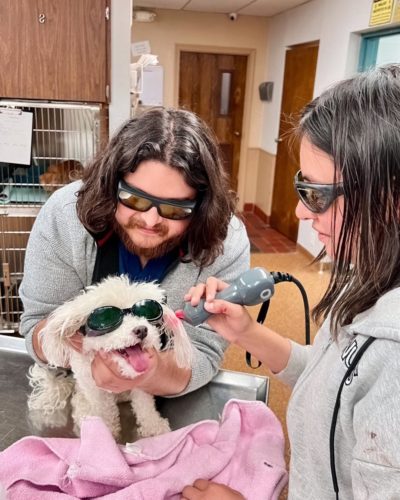
Did you know that cold therapy laser can be a useful adjunct or alternative in treatment of inflammatory disorders such as arthritis, lick granuloma, trauma, ear and skin infections, post- operative pain, and many others? Here at RBAH, we use Companion Laser routinely to help minimize pain, swelling and inflammation. Laser therapy provides a safe, effective and cost efficient alternative to anti-inflammatory and pain medications, thereby minimizing side effects. In some cases, laser therapy can reduce or eliminate the expense and side effects of chronic medication. Clinical studies and trials of laser therapy technology indicate the following beneficial effects of laser therapy on tissues and cells (list courtesy of Valley Veterinary Hospital, www.valleyvethospital.com):
1. Anti-Inflammatory. Laser Therapy has an anti-edema (swelling) effect as it causes vasodilation (expansion of blood vessels), but also because it activates the lymphatic drainage system (drains swollen areas). As a result, there is a reduction in swelling caused by bruising or inflammation.
2. Anti-Pain (Analgesic). Laser Therapy has a beneficial effect on nerve cells by blocking pain transmitted by these cells to the brain and decreasing nerve sensitivity. Due to reduced inflammation, there is less edema and pain. Another pain blocking mechanism involves the production of high levels of pain killing chemicals such as endorphins, enkephlins, and opiods from the brain and adrenal gland.
3. Accelerated Tissue Repair and Cell Growth. Photons of light from lasers penetrate deeply into tissues and accelerate cellular reproduction and growth. The laser light also increases the energy available to the cell by increasing ATP production so that the cell can take on nutrients faster and get rid of waste products. As a result of exposure to laser light, all cells, including the cells of tendons, ligaments and muscles are repaired faster.
4. Improved Vascular Activity. Laser light encourages angiogenesis – the process of new capillary formation in damaged tissues – which speeds up the healing process, contributes to wound closure, and reduces scar tissues. In addition to angiogenesis, there is also increased vasodilation, which feed and helps heal damaged tissue.
5. Increased Metabolic Activity. Laser Therapy creates higher outputs of specific enzymes, greater oxygen and food particle loads for blood cells.
6. Trigger Points and Acupuncture Points. Laser Therapy stimulates muscles trigger points and acupuncture points on a non-invasive basis providing pain relief to muscle and bone.
7. Reduced Fibrous Tissue Formation (scar). Laser Therapy reduces the formation of scar tissue following tissues damaged from cuts, scratches, burns, or surgery.
8. Improved Nerve Function. Slow recovery of nerve function in damaged tissue can result in numbness and impaired limbs. Laser light will speed up the process of axonal regeneration, nerve cell re-connection, and increase the amplitude of action potentials (nerve signals) to optimize muscle/nerve action.
9. Immunoregulation. Laser light has a direct effect on immunity status by stimulation of immunoglobulins and lymphocytes. Laser Therapy is absorbed by chromophores (molecule enzymes) that react to laser light. The enzyme flavomono-nucleotide is activated and starts the production of ATP (adenosine-tri-phosphate), which is the major carrier of cell energy and the energy source for all chemical reactions in the cells.
10. Faster Wound Healing. Laser light stimulates the fibroblast development (fibroblasts are the building blocks of collagen, which is predominant in would healing) in damaged tissue. Collagen is the essential protein required to replace old tissue or repair tissue injuries. As a result, Laser Therapy is effective on open wounds and burns.
Laser Therapy works on following conditions:
- Arthritis, Hip Dysplasia, Elbow Dysplasia, etc.
- Tendonitis
- Wounds
- Post-Surgical Swelling
- Otitis
- Lick Granuloma
- Intervertebral Disc Disease
- Lameness due to soft tissue or bone/cartilage trauma
- Numerous other inflammatory conditions
Treatments usually last 3-5 minutes. Your Pet may experience a comforting warm feeling at treatment site(s). 2-3 treatments may be needed before you notice an improvement. Acute conditions can subside with as few as one set of treatments. Chronic conditions can be managed with regular monthly treatments. There are no known negative adverse events, and it’s very difficult to overdose laser. For more information, please visit http://www.litecure.com/companion/
